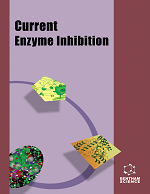- Home
- A-Z Publications
- Current Enzyme Inhibition
- Previous Issues
- Volume 17, Issue 3, 2021
Current Enzyme Inhibition - Volume 17, Issue 3, 2021
Volume 17, Issue 3, 2021
-
-
Targeting Histidine for Developing a New Generation of Covalent Enzyme Inhibitors
More LessDespite the significant number of irreversible inhibitors developed over the years, strong prejudices remain for this type of therapeutic molecule, particularly in the area of drug development. New generations of covalent targeted inhibitors are, however, in development, and interest is increasingly growing. In fact, the new generation of covalent inhibitors has a weakly reactive species (warhead) that is able, in a particul Read More
-
-
-
Identification of Novel Indazole-based Inhibitors of Fibroblast Growth Factor Receptor 1 (FGFR1)
More LessBackground: Overactivity of fibroblast growth factor receptor 1 (FGFR1) is associated with various tumors, particularly breast cancer, prostate cancer, non-small-cell lung carcinoma, myeloproliferative diseases, which makes this protein kinase a promising therapeutic target for anticancer therapy. Objective: The main aim of this study is to identify novel FGFR1 inhibitors. Methods: In order to find FGFR1 inhibitors, virtual scre Read More
-
-
-
Potential Inhibitor of Adenylyl Sulfate Reductase Isolated from Desulfovibrio desulfuricans with PU/PU-Ag to Control Pitting Corrosion of Oil Tanks and Pipelines
More LessAuthors: Wafaa A. Koush, Ahmed Labena, Hany Elsawy, Laila A. Farahat, Tarek M. Mohamed and Maha M. SalemBackground and Aims: This study aims to alleviate the microbiologically affected corrosion that occurred by sulfate-reducing bacteria (SRB) through synthesizing a bio-based polyurethane polymer and its nanocomposite coating, silver nanoparticles (PU-Ag). Moreover, it will also evaluate the effect of PU alone and PU-Ag as inhibitors for adenylyl sulfate reductase (APS), the main enzyme for sulfate reduction. Methods: In this s Read More
-
-
-
In vitro Antioxidant, α-amylase and Horseradish Peroxidase Inhibitory Potential of Phenolics Extracts from Chamomilla pubescens, Pulicaria crispa and Rhanterium adpressum Growing in Algeria
More LessAuthors: Mahfoudi Feriel, Mahfoudi Reguia, Harrat Mohamed, Djeridane Amar and Yousfi MohamedBackground: Plants are the main source of drugs for the therapy of a large number of diseases. Objective: The aim of the present work is to evaluate the in vitro antioxidant and anti-α-amylase and anti- peroxidases (HPR) potentials of phenolic extracts obtained from three spontaneous plants growing in the South of Algeria, namely Chamomilla pubescens, Pulicaria crispa, and Rhanterium adpressum. This is the first repo Read More
-
-
-
Effects of N224 Glycosylation in Saccharomycopsis fibuligera R64 α-Amylase on Enzyme Activity and Stability
More LessBackground: The amino acid sequence of an α-amylase of the yeast Saccharomycopsis fibuligera R64 (SfamyR64) contains two putative N-linked glycosylation sites N153 and N224. N224 is hypothetically responsible for the binding of starch substrate because it is highly conserved among SfamyR64 homologs. Objective: To test whether N224 plays a key role in enzyme activity and stability. Methods: N224Q substitution was i Read More
-
-
-
Biological Characterization and Preliminary Crystallization: A Step Towards the Use of Novel Allium sativum Protease Inhibitor as a Potential Therapeutic Drug
More LessAuthors: Tooba N. Shamsi, Sumbul Afreen, Romana Parveen, Manish Kumar, Tasneem Fatma and Sadaf FatimaBackground: Garlic, being a well-known medicinal plant, is the most commonly used culinary spice worldwide. Investigation of protease inhibitor isolated from garlic leads to a promising contender in pharmacognostic and pharmacological studies. Objective/Introduction: Protease Inhibitor (PI) from 'garlic' (Allium sativum) was analyzed for its biological role as an antioxidant, antimicrobial, and anti-inflammatory agent. Methods: Read More
-
-
-
Experimental and Computational Insights into Bis-indolylmethane Derivatives as Potent Antimicrobial Agents Inhibiting 2,2-dialkylglycine Decarboxylase
More LessAuthors: Dnyaneshwar T. Nagre, Bapu R. Thorat, Suraj N. Mali, Mazhar Farooqui and Brijmohan AgrawalBackground: A series of bis(indolyl)methanes (3a-3o) have been synthesized using a greener and new approach using the reaction of different substituted aldehydes and indole in the presence of an easily available and biodegradable base such as piperidine in acetic acid at room temperature and characterized with UV (Ultraviolet-visible spectroscopy), Gas Chromatography-Mass Spectrometry (GCMS), Proton Nucl Read More
-
-
-
Isolation of Actinomycetes and Screening for Lipase Inhibitors Production
More LessAuthors: Shivabai Chandwad, Chandrasen Chandwad and Sudhakar GutteBackground: Obesity is a growing global health problem. Obesity leads to cardiovascular disorders, musculoskeletal disorders, diabetes, and certain types of cancer. One of the approaches to controlling and treating obesity has involved inhibition of dietary lipid digestion by pancreatic lipase inhibitors. Microbes and plant sources provide a rich source of enzyme inhibitors, including pancreatic lipase inhibitors that can be devel Read More
-
-
-
The Inhibitory Effects of Some Artificial Food Colorings on α-amylase and α-glucosidase: In vitro and In silico Studies
More LessAuthors: Reguia Mahfoudi, Amar Djeridane, Djilali Tahri and Mohamed YousfiBackground: Inhibition of α-amylase and α-glucosidase is considered as an important therapeutic target to manage type 2 diabetes mellitus (T2DM), reducing postprandial hyperglycemia (PPHG). Objective: The present work explored the antidiabetic activities of five artificial food colorings by α- amylase and α-glucosidase enzyme inhibition in vitro and in Silico. Methods: In this study, inhibition of α-amylase and α-glucosidas Read More
-
Volumes & issues
-
Volume 20 (2024)
-
Volume 19 (2023)
-
Volume 18 (2022)
-
Volume 17 (2021)
-
Volume 16 (2020)
-
Volume 15 (2019)
-
Volume 14 (2018)
-
Volume 13 (2017)
-
Volume 12 (2016)
-
Volume 11 (2015)
-
Volume 10 (2014)
-
Volume 9 (2013)
-
Volume 8 (2012)
-
Volume 7 (2011)
-
Volume 6 (2010)
-
Volume 5 (2009)
-
Volume 4 (2008)
-
Volume 3 (2007)
-
Volume 2 (2006)
-
Volume 1 (2005)
Most Read This Month
Article
content/journals/cei
Journal
10
5
false
en


